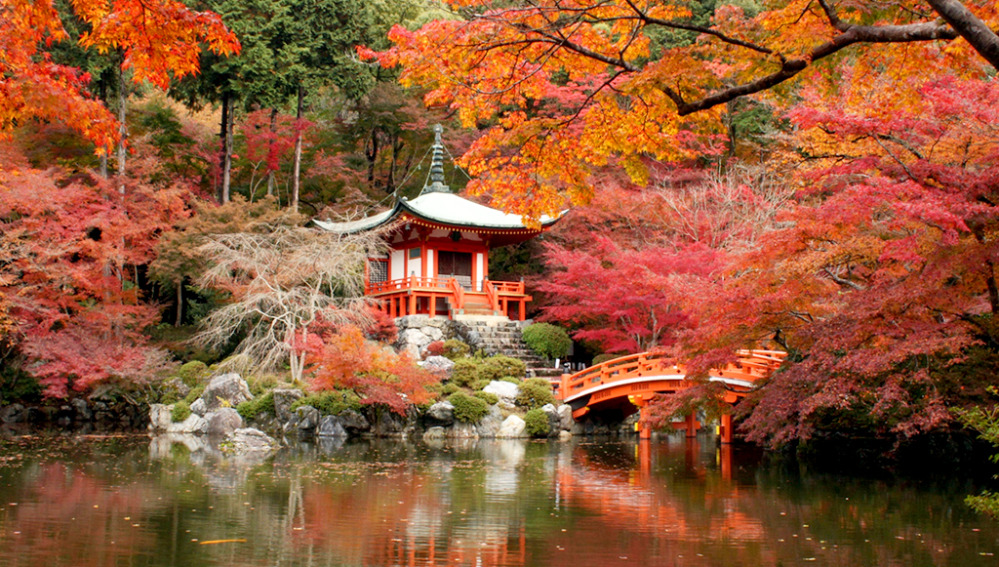The intense red takes the Daigoji temple,Japan

Daigoji Temple is an important temple of the Shingon sect of Japanese Buddhism. One of the must-see in Kyoto, this temple becomes even more beautiful in autumn. Now is when his famous room Bentendo charges a special frame, all red, like the fire that seems to be reflected in the building.
UNESCO World Heritage Site, with many national treasures and cultural assets, the great complex of this temple covers the entire mountain of Daigo-san, and is one of the largest in Kyoto.
More than 80 buildings are divided between the bottom and the top of the mountain, connected through a spectacular hiking trail. Outside the usual tourist circuits, there are not usually many people, which will allow you to feel the peace and calm of this millenary site.
About the Daigo-ji temple
Upon entering the grounds of the Daigoji temple, the first thing we will find is the Sanboin, the former and elegant residence of the high priest, dating from 1115. Sanboin is an imperial temple and within this temple, you will find the Sanboin Garden, a national treasure that has 800 rocks. The current building was rebuilt and expanded, and is the place where the famous cherry blossom festival of Toyotomi Hideyoshi is celebrated.
The building is an excellent example of the extravagant Momoyama architecture that you should not miss. Just as the Temple of Abu Simbel is one of the jewels of Egypt, a huge shrine dedicated to Pharaoh Ramses II.
A few steps away, the Shimo Daigo area is where most of Daigoji’s other important buildings are located. Among them the Kondo Hall, or main hall, which was originally built in 926. The current building was relocated to Daigoji in 1599 and stores objects of worship and a statue of the Yakushi Buddha.
Daigoji Temple Structure
In this part of the complex there is a five-story pagoda, which is 38 meters high, and is currently the oldest building in Kyoto. Built in 951, the pagoda is the only structure that has come intact to this day, despite the fires that have destroyed Daigoji over the centuries.
And finally the most photographed construction of Daigoji, next to a pond in the back of the Shimo Daigo area, the Bentendo room, especially beautiful at the end of November, when it is surrounded by the intense colors of autumn.
Also in this area, the Reihokan Museum, preserves treasures and a large collection of historical documents and objects of temple art. Some of the most impressive trees in the temple are in the garden of this museum, cherry trees that reach exceptional beauty in April.
Daigoji is divided into two parts: kami and shimo, or what is the same, top and bottom. Most visitors stay at the bottom where the most famous buildings and the pagoda are located, but if you have time, it is worth climbing up to Kami Daigo, the top.
The road is beautiful and the historic buildings are surrounded by trees and bamboo forests.
It takes about an hour to climb the steep path but the route that passes through lonely wooden corridors among the trees of dense forest, is simply a unique experience.
A different way to enjoy nature, beauty, silence and views, which on clear days reach the city of Osaka.
In Kami Daigo we can see the Nyonindo or Hall of Women, the Seiryu Gongengu, a Shinto shrine dating from 1434, the Junteido that contains an image of Kannon, the goddess of mercy, and the Yakushido dating from 1121 and which is a national treasure, with an image of the Yakushi Nyorai, which is believed to have been carved in 907.
At the top of the hill there are three more buildings: Godaido, Nyoirindo and Kaisando, the latter two with beautiful cypress roofs dating back to the end of the 17th century.
Kyoto is one of the most beautiful cities in Japan, and in autumn the red and ocher colors take over their gardens, there is nothing like the magic of this season in this beautiful corner of Japan.


